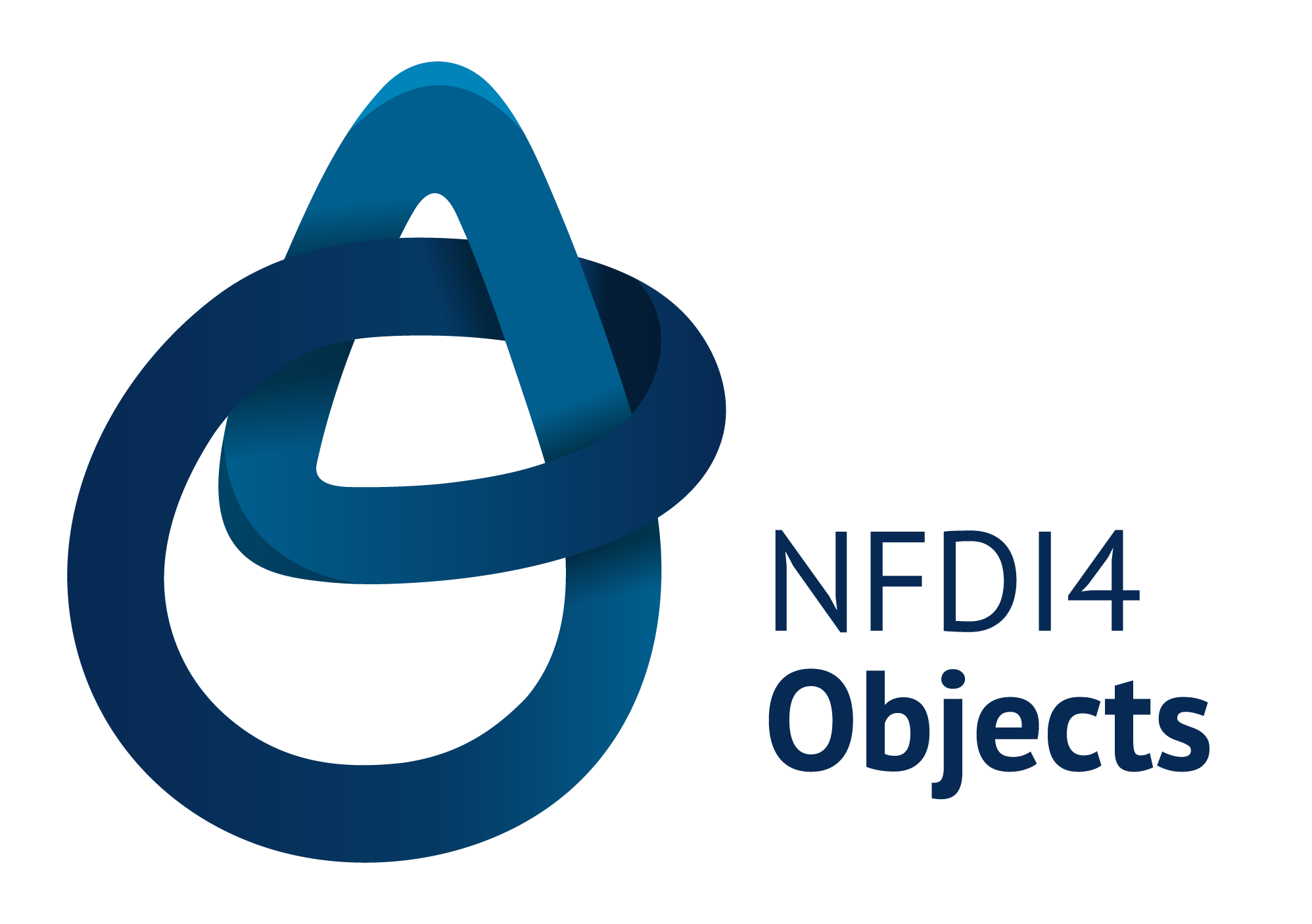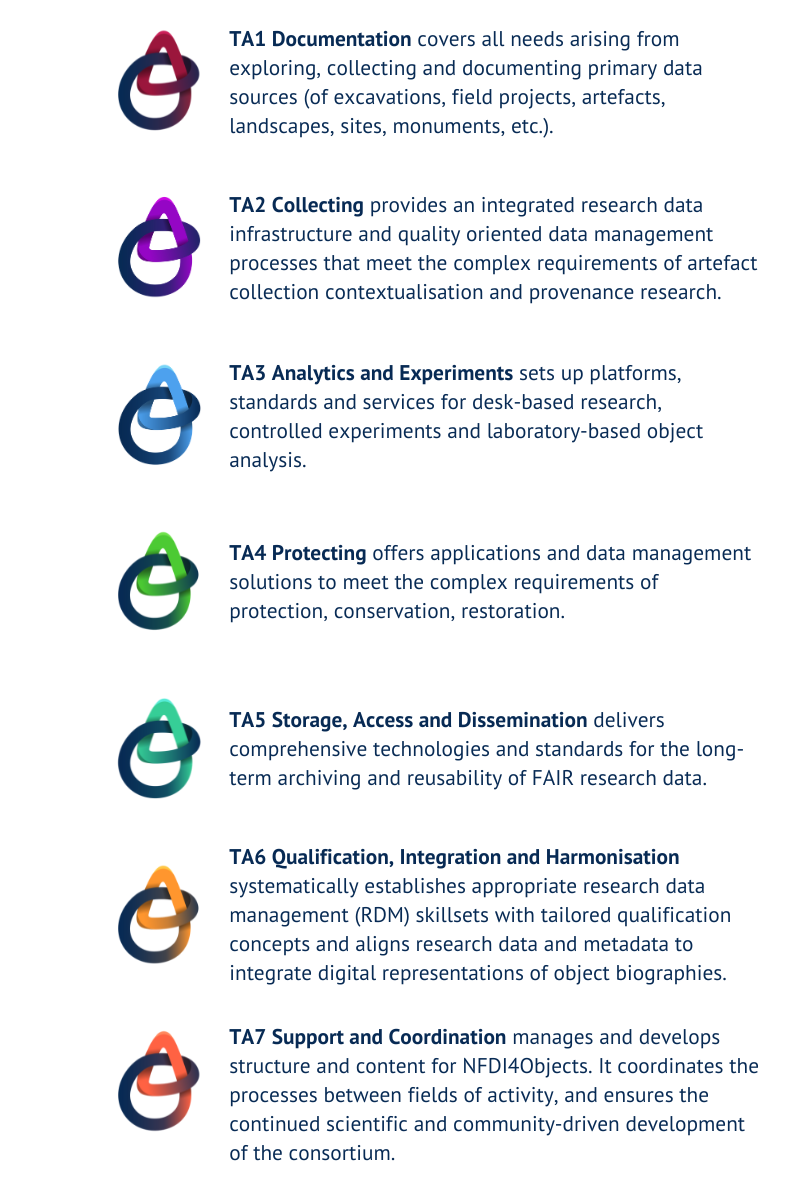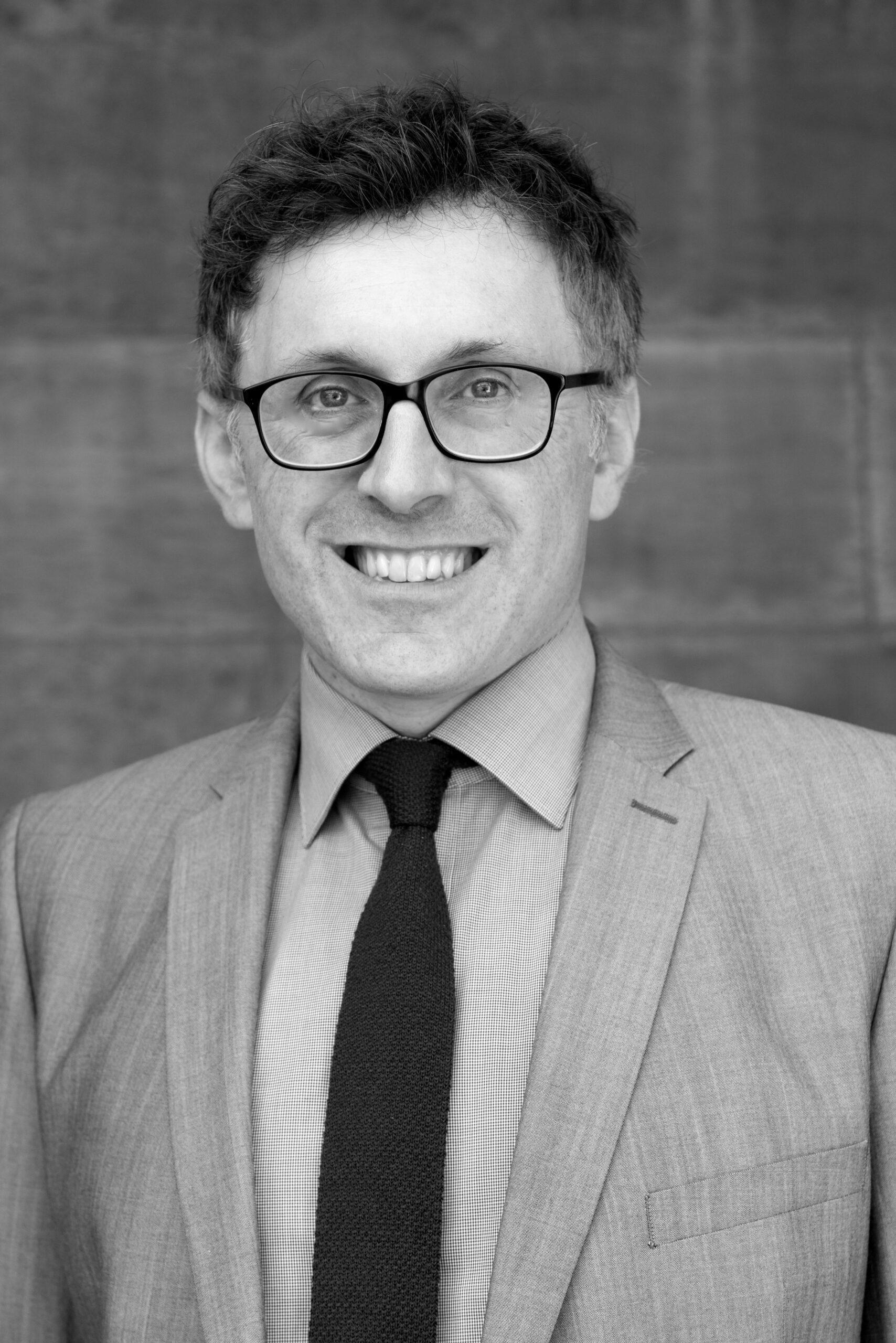
About us
Material legacies are fundamental sources for the cultural and biological development of mankind. Man-made tools, built monuments and shaped landscapes provide information about technological developments, innovations, human-environment relationships, migration, cultural exchange and change. Comprehensive analyses and contextual information make these remains more meaningful. However, the diversity of objects, contexts and complex object biographies pose a challenge for digital research processes. NFDI4Objects addresses the needs of researchers and practitioners focussing on the material remains of human and environmental history. The community includes research institutions, museums, archives and heritage agencies working in the fields of archaeology and its many neighbouring disciplines, from anthropology and archaeozoology to building research and restoration.
Within the German National Research Data Infrastructure (NFDI), the consortium develops community-driven and science-led solutions to the challenges of managing existing and heterogeneous data sets. These include 3D scans of excavation sites, photographs and drawings of artefacts, biological and chemical analyses of excavation objects and archaeological finds mapping. Uniform and reliable data services are being developed by and for scientists in various task areas in order to promote the digitisation, simplification and standardisation of this diverse research data. This includes the development of a uniform, digital long-term archive for archaeological research and standard data as well as the creation of a standard vocabulary. This will not only ensure the sustainability and findability, but also the national and international comparability of research data and solve the problem of heterogeneous and confusing data sets in the long term.
Goals
- to provide reliable and interoperable data services for all phases of the FAIR data lifecycle
- to promote awareness of data quality as a central element of research data management
- to improve the quality of research data through FAIR standards and workflows
- to implement, harmonise and extend data standards including metadata models
- to strengthen cross-cutting topics in collaboration with the entire NFDI
- to connect NFDI4Objects to the national and international research landscape
Task Areas


Dr. Philipp von Rummel
Speaker of the consortium
(Co-)applicant institutions and (co-)speakers:
- Benjamin Höke, Landesamt für Denkmalpflege Baden-Württemberg
- Matthias Lang, University of Bonn
- Alexandra Busch, Römisch-Germanisches Zentralmuseum, Leibniz Research Institute for Archaeology
- Bernard Weisser, Münzkabinett, Staatliche Museen zu Berlin, Stiftung Preußischer Kulturbesitz
- Matthias Renz, University of Kiel
- Thomas Stöllner, Deutsches Bergbau-Museum Bochum, Leibniz Research Museum for Geo-resources
- Roland Schwab, Römisch-Germanisches Zentralmuseum, Leibniz Research Institute for Archaeology
- Ulrich Himmelmann, Generaldirektion Kulturelles Erbe Rheinland-Pfalz
- Frank Dührkohp, Verbundzentrale des Gemeinsamen Bibliotheksverbund (GBV)
- Henriette Senst, German Archaeological Institute
- Kai-Christian Bruhn, Mainz University of Applied Sciences
- Dirk Wintergrün, Klassik Stiftung Weimar

German Archaeological Institute, Head Office Berlin
Applicant institution
Participating Institutions
- Academy of Sciences and Literature Mainz
- Bavarian State Archaeological Collection
- Museum for Prehistoric and Early Medieval Archaeology
- Archaeological Museum Hamburg
- Berlin-Brandenburg Academy of Sciences and Humanities
- Computer Applications and Quantitative Methods in Archaeology
- Curt Engelhorn Centre for Archaeometry
- German Society for Pre- and Protohistory
- German National Library
- German Library Association
- German Museum Association
- University of Tübingen
- FIZ Karlsruhe
- Freie Universität Berlin
- Friedrich-Alexander-Universität Erlangen-Nürnberg
- Friedrich-Schiller-Universität Jena
- Thuringian University and State Library Jena
- Georg-August-Universität Göttingen
- Niedesächsische Staats- und Universitätsbibliothek Göttingen
- Heidelberg Academy of Sciences and Humanities
- Helmholtz Centre for Environmental Research
- Herzog Anton Ulrich-Museum, Braunschweig
- Landesamt für Denkmalpflege Hessen
- University of Applied Sciences und Arts Hildesheim/Holzminden/Göttingen
- University of Applied Sciences Mittweida
- Johannes Gutenberg University Mainz
- Humboldt-Universität zu Berlin
- State Office for Heritage Management and Archaeology Sachsen-Anhalt
- State Museum of Prehistory, Halle
- State Office for Heritage Management Saarland
- Niedersächsisches Landesmuseum Hannover
- Max-Planck-Institut für Evolutionäre Anthropologie
- LVR-Amt für Bodendenkmalpflege im Rheinland
- LWL-Museum für Archäologie und Kultur
- Westfälisches Landesmuseum
- Museum für Naturkunde Berlin
- Lower Saxony Institute for Historical Coastal Research
- Niedersächsisches Landesamt für Denkmalpflege
- University of Bamberg
- RWTH Aachen University
- Ruhr-Universität Bochum
- Heidelberg University
- Archives of the Bavarian State
- Staatssammlung für Anthropologie München
- The Schleswig-Holstein State Museums Foundation Schloss Gottorf
- Technische Universität Berlin
- Technische Universität Braunschweig
- Technische Universität Darmstadt
- Landesamt für Denkmalpflege und Archäologie (LDA Thuringia)
- TIB – Leibniz Information Centre for Science and Technology
- Universität Hamburg
- University of Cologne
- Leipzig University
- VARUSSCHLACHT im Osnabrücker Land gGmbH
- Verband der Landesarchäologien in der Bundesrepublik Deutschland e. V.

Dr. Philipp von Rummel
Speaker of the consortium

German Archaeological Institute, Head Office Berlin
Applicant institution
(Co-)applicant institutions and (co-)speakers:
- Benjamin Höke, Landesamt für Denkmalpflege Baden-Württemberg
- Matthias Lang, University of Bonn
- Alexandra Busch, Römisch-Germanisches Zentralmuseum, Leibniz Research Institute for Archaeology
- Bernard Weisser, Münzkabinett, Staatliche Museen zu Berlin, Stiftung Preußischer Kulturbesitz
- Matthias Renz, University of Kiel
- Thomas Stöllner, Deutsches Bergbau-Museum Bochum, Leibniz Research Museum for Geo-resources
- Roland Schwab, Römisch-Germanisches Zentralmuseum, Leibniz Research Institute for Archaeology
- Ulrich Himmelmann, Generaldirektion Kulturelles Erbe Rheinland-Pfalz
- Frank Dührkohp, Verbundzentrale des Gemeinsamen Bibliotheksverbund (GBV)
- Henriette Senst, German Archaeological Institute
- Kai-Christian Bruhn, Mainz University of Applied Sciences
- Dirk Wintergrün, Klassik Stiftung Weimar
Participating Institutions
- Academy of Sciences and Literature Mainz
- Bavarian State Archaeological Collection
- Museum for Prehistoric and Early Medieval Archaeology
- Archaeological Museum Hamburg
- Berlin-Brandenburg Academy of Sciences and Humanities
- Computer Applications and Quantitative Methods in Archaeology
- Curt Engelhorn Centre for Archaeometry
- German Society for Pre- and Protohistory
- German National Library
- German Library Association
- German Museum Association
- University of Tübingen
- FIZ Karlsruhe
- Freie Universität Berlin
- Friedrich-Alexander-Universität Erlangen-Nürnberg
- Friedrich-Schiller-Universität Jena
- Thuringian University and State Library Jena
- Georg-August-Universität Göttingen
- Niedesächsische Staats- und Universitätsbibliothek Göttingen
- Heidelberg Academy of Sciences and Humanities
- Helmholtz Centre for Environmental Research
- Herzog Anton Ulrich-Museum, Braunschweig
- Landesamt für Denkmalpflege Hessen
- University of Applied Sciences und Arts Hildesheim/Holzminden/Göttingen
- University of Applied Sciences Mittweida
- Johannes Gutenberg University Mainz
- Humboldt-Universität zu Berlin
- State Office for Heritage Management and Archaeology Sachsen-Anhalt
- State Museum of Prehistory, Halle
- State Office for Heritage Management Saarland
- Niedersächsisches Landesmuseum Hannover
- Max-Planck-Institut für Evolutionäre Anthropologie
- LVR-Amt für Bodendenkmalpflege im Rheinland
- LWL-Museum für Archäologie und Kultur
- Westfälisches Landesmuseum
- Museum für Naturkunde Berlin
- Lower Saxony Institute for Historical Coastal Research
- Niedersächsisches Landesamt für Denkmalpflege
- University of Bamberg
- RWTH Aachen University
- Ruhr-Universität Bochum
- Heidelberg University
- Archives of the Bavarian State
- Staatssammlung für Anthropologie München
- The Schleswig-Holstein State Museums Foundation Schloss Gottorf
- Technische Universität Berlin
- Technische Universität Braunschweig
- Technische Universität Darmstadt
- Landesamt für Denkmalpflege und Archäologie (LDA Thuringia)
- TIB – Leibniz Information Centre for Science and Technology
- Universität Hamburg
- University of Cologne
- Leipzig University
- VARUSSCHLACHT im Osnabrücker Land gGmbH
- Verband der Landesarchäologien in der Bundesrepublik Deutschland e. V.
Use Cases
Mobile recording of archaeological finds
The majority of small archaeological finds are deposited by authorised explorers, volunteers and accidental finders. These new finds represent an important scientific source for research. The finds are usually physically handed in to heritage conservation offices and reports are often hand-written. Subsequent transfer of the data to the existing data infrastructures of the state offices involves considerable effort for all parties involved. As part of NFDI4Objects, an infrastructure is to be developed for the mobile recording of small archaeological finds, including the upload of data to the central databases. The data is to be made available via standardised interfaces for processing the finds in the databases of the heritage offices of the federal states. In this way, the finders can not only provide information about the artefacts, the data is also immediately made available to the scientific community for research.
Digital long-term archive for archaeological research data
Across Germany, a large amount of data is collected every day in various archaeological and ancient studies research projects. Be it 3D scans of excavation sites, photographs of artefacts, chemical, biological and geological microanalyses of ceramics, site sketches or object histories – all this research data is usually stored in a decentralised, project-related and temporary manner and can therefore only be found and used by others to a limited extent. This problem is to be solved by creating a standardised, digital long-term archive for the material heritage of around three million years of human and environmental history. To this end, NFDI4Objects is setting up a digital infrastructure that functions according to the FAIR principles and will simplify and standardise research data management in the long term.
Improving digital provenance research
Digital provenance research faces the challenge of restoring lost contexts of museum objects by reconstructing networks of previous owners. One example is the architect Ernst Lebach, who sold 63 antique glasses to the Römisch-Germanisches Zentralmuseum between 1912 and 1914. The acquisition history was reconstructed by classical archaeologist Ernst Künzl in 2015. As Lebach cannot be researched digitally, this is where the digital provenance research of NFDI4Objects comes in. The development of digital research data infrastructures is necessary in order to contextualise and link objects in (museum) collection databases. Standardised data, especially for personal names, has been lacking in provenance research to date. NFDI4Objects is working on establishing standardised data repositories in order to link them with the German National Library’s Common Authority File (GND) and international standardised data portals and to develop a network of data on previous owners.
Increasing the comparability of data
In order to fulfil the diverse requirements of different databases and portals for standards data, it makes sense to provide the standards vocabularies via a central service with defined interfaces. Such a service, called DANTE (Datendrehscheibe für Normdaten und Terminologien) is being developed by the GBV’s central repository as a central resource for the NFDI4Objects community and offers international connectivity. DANTE enables networking with national and international data sources. Centralisation in DANTE resolves the previous multiple provision of standard data and vocabularies in different databases, which simplifies maintenance, servicing and updates. All types of keyword lists, thesauri and standardisation data can be imported into DANTE and shared, and terminologies that were previously difficult to access are also stored there.